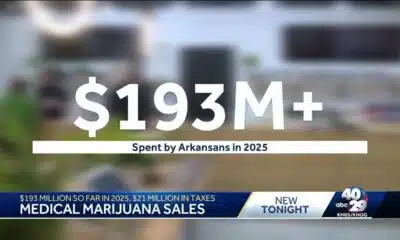News from the South - Arkansas News Feed
REAL ID requirements among policies difficult for transgender, nonbinary Arkansans to navigate
by Tess Vrbin, Arkansas Advocate
April 30, 2025
Gender-nonconforming Arkansans might not meet the state’s requirements to obtain a REAL ID in order to board flights or enter certain federal buildings, which is a week away from being required by federal law.
Applicants for REAL IDs need to provide the Department of Finance and Administration with four different forms of identification:
A current driver’s license, state-issued ID, or school or work ID as proof of identityA passport or birth certificate as proof of legal presence in the United StatesA government-issued social security cardTwo documents providing proof of address, such as utility bills or bank statements, issued within the last six months
The documents “all have to sync up,” Finance Secretary Jim Hudson said last week.
Transgender and nonbinary Arkansans might have changed their names or gender information on some but not all legal documents, and state policies have made it difficult for these groups of people to obtain documents that accurately reflect who they are, advocates say. Birth certificates can be legally altered, and until this year, the federal government allowed gender-neutral information on U.S. passports.
“The government has played politics with people’s lives and upended people’s ability to accurately and properly identify themselves,” said Holly Dickson, executive director of the American Civil Liberties Union of Arkansas. “This has created much chaos and turmoil for no good reason while making life harder and more unsafe for all of us.”
Last year, the ACLU of Arkansas led a lawsuit against the DFA’s decision to stop issuing gender-neutral driver’s licenses. The case was dropped after Arkansas officials permanently adopted the new policy, which prohibits the use of an “X” to indicate someone’s gender in place of “M” or “F.”
Arkansans urge state finance department not to reverse gender-neutral driver’s license policy
Several transgender and nonbinary Arkansans, including Maggs Gallup of Little Rock, urged the finance department to maintain the previous policy, which had been in place for 14 years. Gallup said in an interview Monday that they are putting off obtaining a REAL ID in case doing so requires the state to remove the X gender marker from their driver’s license.
Hudson told lawmakers that a driver’s license is “not a platform for speech” and “not a platform for personal identity.” Gallup disagreed, saying their gender-neutral ID is important to them and putting incorrect information on an ID is “a deeply incongruent thing to do.”
“In an ideal world, it would be great to have the state and officials recognize our gender,” Gallup said. “They don’t get to determine who we are, no matter what letters we put on our IDs.”
REAL IDs began with a law passed by Congress in 2005 as a response to the Sept. 11, 2001, terrorist attacks. Instituting REAL IDs statewide “will help fight terrorism and reduce identity fraud,” according to the finance department website.
The federal Transportation Security Administration accepts passports in place of REAL IDs as identification to board a flight. Miss Major Griffin-Gracy, a well-known transgender advocate who lives in Little Rock, said last week on Facebook that she was initially denied access to a flight because she has an X on her driver’s license, but she was allowed to board after displaying her passport containing a male gender marker.
Griffin-Gracy is 78 years old and gender-nonconforming, and she was present at the 1969 Stonewall riot between LGBTQ+ people and police in New York City. In her Facebook video, she expressed disbelief that her passport was accepted even though she did not appear masculine. She also said “we the people” should “stand up and fight” President Donald Trump’s administration, which does not recognize gender-neutral IDs.
Gallup said they are also concerned about potential limits on travel, both domestic and international, with or without a REAL ID. Their teenage child is old enough to learn to drive but is putting off obtaining a learner’s permit because of potential bureaucratic obstacles due to their gender-nonconforming identity, Gallup said.
Bill regulating transgender Arkansans’ bathroom use heads to House despite public pushback
“This is just one part of a larger, really complicated network of new rules and legislation that are challenging to navigate” for transgender and nonbinary Arkansans, Gallup said.
State lawmakers and Gov. Sarah Huckabee Sanders approved a law this month that will allow Arkansans to sue for damages if they encounter someone in a bathroom, changing room, shelter or correctional facility who does not align with the “designated sex” of the space.
The state has also enacted laws in the past few years that ban transgender girls from playing girls’ sports, require public school students to use bathrooms that match their gender assigned at birth, regulate pronoun use in schools and allow doctors who provide transgender minors’ health care to be sued for medical malpractice.
GET THE MORNING HEADLINES.
Arkansas Advocate is part of States Newsroom, a nonprofit news network supported by grants and a coalition of donors as a 501c(3) public charity. Arkansas Advocate maintains editorial independence. Contact Editor Sonny Albarado for questions: info@arkansasadvocate.com.
The post REAL ID requirements among policies difficult for transgender, nonbinary Arkansans to navigate appeared first on arkansasadvocate.com
Note: The following A.I. based commentary is not part of the original article, reproduced above, but is offered in the hopes that it will promote greater media literacy and critical thinking, by making any potential bias more visible to the reader –Staff Editor.
Political Bias Rating: Center-Left
The article appears to adopt a Center-Left perspective primarily through its focus on issues affecting transgender and nonbinary individuals, particularly with regard to identity documentation requirements in Arkansas. It emphasizes the challenges faced by gender-nonconforming individuals in obtaining accurate identification and highlights criticisms from the American Civil Liberties Union (ACLU) regarding the state’s policy changes. The language used is sympathetic toward these groups, portraying the state’s actions as creating unnecessary turmoil and being politically motivated. Although the article provides factual information about the REAL ID process and relevant legal actions, its framing leans toward advocacy for the rights of transgender individuals, positioning the state’s policies in a critical light. This reflects a broader pattern of liberal advocacy for gender inclusivity in government identification practices. However, the piece does offer direct quotes from state officials, which helps balance the presentation of opposing views. Thus, the overall tone remains more supportive of progressive policies on gender identification, hence the Center-Left categorization.
News from the South - Arkansas News Feed
NW Arkansas Championship expected to bring money to Rogers
SUMMARY: The Northwest Arkansas Championship in Rogers is more than a golf event; it significantly boosts the local economy. Drawing thousands annually, it brings steady crowds benefiting restaurants, shops, and service providers. Businesses report increased sales, especially in food and hydration products, with parking lots near the course filling quickly. The Rogers Chamber estimates the tournament injects around $14 million into the local economy, supporting small businesses. Starting tomorrow with a 5K event at the LPGA, this week-long tournament is a dependable source of customer traffic and highlights Rogers’ growth as a regional hub.
Rogers businesses make money off the LPGA’s NW Arkansas Championship.
40/29 is your home for Northwest Arkansas and the River Valley breaking news and weather. For your latest Northwest Arkansas and the River Valley news and weather visit: https://www.4029tv.com/
For licensing inquiries: https://www.4029tv.com/licensing
News from the South - Arkansas News Feed
Arkansas medical marijuana sales on pace for record year
SUMMARY: Arkansas medical marijuana sales are on track for a record year, with patients spending over $193 million from January to August 2025—more than $10 million higher than last year. The state currently has 109,000 active patient cards, purchasing over 52,000 pounds of cannabis products. Daily sales average around $800,000, generating more than $21 million in taxes this year. A new law directs part of this tax revenue to combat food insecurity, including eliminating school lunch debt statewide. Since 2019, Arkansas patients have spent over $1.5 billion on medical marijuana, with the state collecting more than $105 million in taxes.
Arkansas medical marijuana sales on pace for record year 40/29 is your home for Northwest Arkansas and the River Valley …
News from the South - Arkansas News Feed
Group in lawsuit say Franklin county prison land was bought before it was inspected
SUMMARY: A group filed a complaint against the Franklin County Prison project, claiming the land was purchased before proper inspection, resulting in unsuitable property acquisition and wasted taxpayer money. A study cited by State Senator Brian King revealed the site cannot supply adequate water for even one home, let alone a 3,000-bed prison. Despite ongoing prison overcrowding and the need for a new facility, concerns remain about the project’s viability. Lawmakers discussed the issue, highlighting overcrowding and early release of violent offenders due to lack of space. The Franklin County Prison project aims to build a 3,000-bed facility, but its future is uncertain amid these challenges.
Group in lawsuit say Franklin county prison land was bought before it was inspected
40/29 is your home for Northwest Arkansas and the River Valley breaking news and weather. For your latest Northwest Arkansas and the River Valley news and weather visit: https://www.4029tv.com/
For licensing inquiries: https://www.4029tv.com/licensing
-
News from the South - Missouri News Feed7 days ago
Pulaski County town faces scrutiny after fatal overdose
-
News from the South - Arkansas News Feed6 days ago
Group in lawsuit say Franklin county prison land was bought before it was inspected
-
News from the South - Kentucky News Feed5 days ago
Lexington man accused of carjacking, firing gun during police chase faces federal firearm charge
-
Mississippi News Video7 days ago
Carly Gregg convicted of all charges
-
Mississippi News Video7 days ago
2025 Mississippi Book Festival announces sponsorship
-
News from the South - Arkansas News Feed6 days ago
Arkansas medical marijuana sales on pace for record year
-
The Center Square6 days ago
California mother says daughter killed herself after being transitioned by school | California
-
News from the South - Missouri News Feed6 days ago
Local, statewide officials react to Charlie Kirk death after shooting in Utah












































